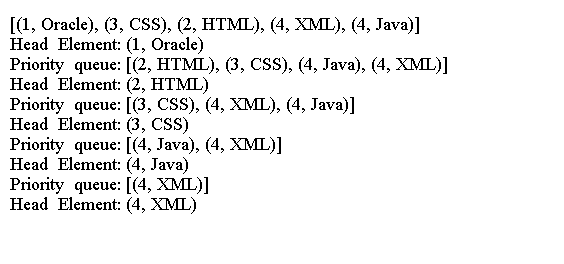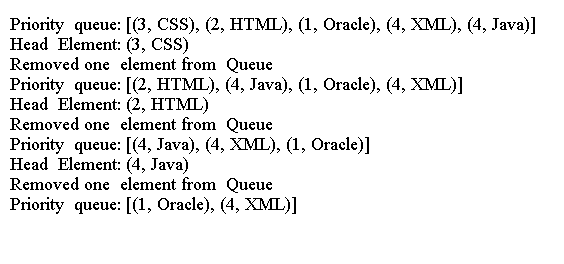Java隊列
Java優先級隊列
優先級隊列是其中每個元素具有相關聯的優先級的隊列。具有最高優先級的元素將從隊列中刪除。
PriorityQueue 是一個實現類對于Java Collection Framework中的無界優先級隊列。
我們可以使用在每個元素中實現的 Comparable 接口作為其優先事項。
或者我們可以提供一個 Comparator 對象,這將確定元素的優先級順序。
當向優先級隊列添加新元素時,它將根據其優先級位于隊列中。
例子
import java.util.PriorityQueue;
import java.util.Queue;
class ComparablePerson implements Comparable<ComparablePerson> {
private int id;
private String name;
public ComparablePerson(int id, String name) {
this.id = id;
this.name = name;
}
public int getId() {
return id;
}
public void setId(int id) {
this.id = id;
}
public String getName() {
return name;
}
public void setName(String name) {
this.name = name;
}
@Override
public boolean equals(Object o) {
if (!(o instanceof ComparablePerson)) {
return false;
}
ComparablePerson p = (ComparablePerson) o;
if (this.id == p.getId()) {
return true;
}
return false;
}
@Override
public int hashCode() {
return this.id;
}
@Override
public String toString() {
return "(" + id + ", " + name + ")";
}
@Override
public int compareTo(ComparablePerson cp) {
int cpId = cp.getId();
String cpName = cp.getName();
if (this.getId() < cpId) {
return -1;
}
if (this.getId() > cpId) {
return 1;
}
if (this.getId() == cpId) {
return this.getName().compareTo(cpName);
}
// Should not reach here
return 0;
}
}
public class Main {
public static void main(String[] args) {
Queue<ComparablePerson> pq = new PriorityQueue<>();
pq.add(new ComparablePerson(1, "Oracle"));
pq.add(new ComparablePerson(4, "XML"));
pq.add(new ComparablePerson(2, "HTML"));
pq.add(new ComparablePerson(3, "CSS"));
pq.add(new ComparablePerson(4, "Java"));
System.out.println(pq);
while (pq.peek() != null) {
System.out.println("Head Element: " + pq.peek());
pq.remove();
System.out.println("Priority queue: " + pq);
}
}
}
上面的代碼生成以下結果。

注意
當您使用迭代器時, PriorityQueue 類不保證元素的任何順序。
它的toString()方法使用它的迭代器給你的元素的字符串表示。
以下代碼顯示如何使用 Comparator 對象為ComparablePerson列表創建優先級隊列。
import java.util.Comparator;
import java.util.PriorityQueue;
import java.util.Queue;
class ComparablePerson implements Comparable<ComparablePerson> {
private int id;
private String name;
public ComparablePerson(int id, String name) {
this.id = id;
this.name = name;
}
public int getId() {
return id;
}
public void setId(int id) {
this.id = id;
}
public String getName() {
return name;
}
public void setName(String name) {
this.name = name;
}
@Override
public boolean equals(Object o) {
if (!(o instanceof ComparablePerson)) {
return false;
}
ComparablePerson p = (ComparablePerson) o;
if (this.id == p.getId()) {
return true;
}
return false;
}
@Override
public int hashCode() {
return this.id;
}
@Override
public String toString() {
return "(" + id + ", " + name + ")";
}
@Override
public int compareTo(ComparablePerson cp) {
int cpId = cp.getId();
String cpName = cp.getName();
if (this.getId() < cpId) {
return -1;
}
if (this.getId() > cpId) {
return 1;
}
if (this.getId() == cpId) {
return this.getName().compareTo(cpName);
}
// Should not reach here
return 0;
}
}
public class Main {
public static void main(String[] args) {
int initialCapacity = 5;
Comparator<ComparablePerson> nameComparator = Comparator
.comparing(ComparablePerson::getName);
Queue<ComparablePerson> pq = new PriorityQueue<>(initialCapacity,
nameComparator);
pq.add(new ComparablePerson(1, "Oracle"));
pq.add(new ComparablePerson(4, "XML"));
pq.add(new ComparablePerson(2, "HTML"));
pq.add(new ComparablePerson(3, "CSS"));
pq.add(new ComparablePerson(4, "Java"));
System.out.println("Priority queue: " + pq);
while (pq.peek() != null) {
System.out.println("Head Element: " + pq.peek());
pq.remove();
System.out.println("Removed one element from Queue");
System.out.println("Priority queue: " + pq);
}
}
}
上面的代碼生成以下結果。







